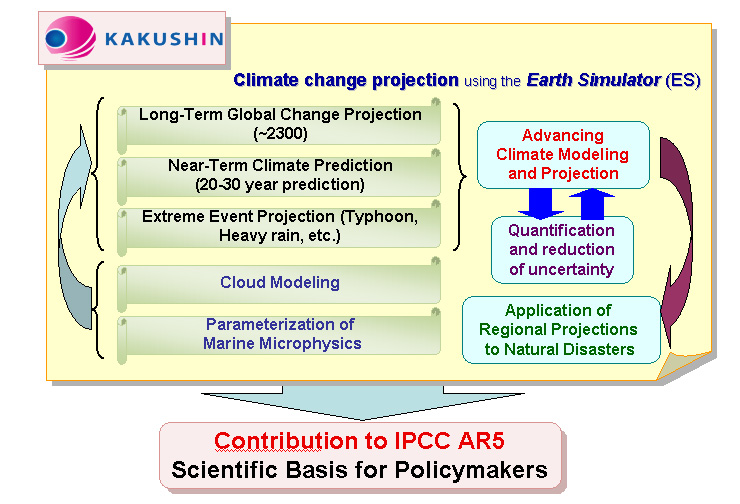General Description

The third phase (FY2006 - 2010) of Japan's Science and Technology Basic Plan began in April 2006, with priorities focusing on the same four fields as the second phase. One of these priority fields is research on the environment, within which climate change research is one of the five focus areas.
As part of this national strategy, the Ministry of Education, Culture, Sports, Science and Technology (MEXT) has launched a 5-year (FY2007 - 2011) initiative called the Innovative Program of Climate Change Projection for the 21st Century (KAKUSHIN Program ), using the Earth Simulator (ES) to address emerging research challenges, such as those derived from the outcomes of the MEXT's Kyosei Project (FY2002 - 2006), that has made substantial contributions to the Fourth Assessment Report (AR4) of the Intergovernmental Panel on Climate Change (IPCC). The KAKUSHIN Program is expected to further contribute to the Fifth Assessment Report (AR5).
Considering the strong worldwide concerns regarding global warming, and particularly, its potential impact on
natural disasters caused by increasingly severe extreme weather events, the KAKUSHIN Program is targeting three
major themes:
- Advancing climate modeling and projection for better simulation of physical and biogeochemical processes by sufficient reflection of feedbacks;
- Quantification and reduction of uncertainty for more reliable projections of climate change using model comparisons and other methodologies;
- Application of regional projections to natural disasters for better assessments of natural disasters caused by extreme events using sufficiently high-resolution regional projection.
Three teams participating in the KAKUSHIN Program are covering these three themes through the following
respective foci. Each abridged study title is followed by the main research organization involved; see the following
pages for study details.
- Long-Term Global Change Projection: Frontier Research Center for Global Change (FRCGC/JAMSTEC);
- Near-Term Climate Prediction: Center for Climate System Research (CCSR), the University of Tokyo;
- Extreme Event Projection: Meteorological Research Institute (MRI).
In addition, two other teams are conducting process studies for theme (A):